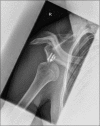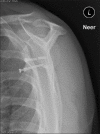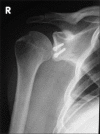10 Years of Arthroscopic Latarjet Procedure: Outcome and Complications
- PMID: 30905989
- PMCID: PMC6394195
- DOI: 10.4103/ortho.IJOrtho_273_17
10 Years of Arthroscopic Latarjet Procedure: Outcome and Complications
Abstract
Background: The treatment of anterior glenohumeral instability with a Bankart repair combined with a capsular plication is a frequently used arthroscopic technique. Latarjet created an open bone block procedure in 1954 for the treatment of anteroinferior glenohumeral instability. This procedure has been further developed by Lafosse in 2003 for arthroscopic surgery. The aim of this study is to evaluate the clinical outcome and complications of the latter procedure, most notably infection rate and nerve damage.
Materials and methods: 132 shoulders (106 males/19 females, 68 right/64 left) were included in this retrospective study. Patients were included if treatment was performed for anterior instability and if the patient's instability severity index score was at least 4, or if a revision procedure was performed after a prior unsuccessful arthroscopic or open capsule and labral repair. Treatment included the arthroscopic transfer of the coracoid process for the anterior stabilization of the shoulder joint. The disabilities of the arm, shoulder, and hand score were evaluated postoperatively in 76 patients and compared with the results found in the literature. Mean followup was 20.1 [±14.09] months.
Results: The rate of recurrent glenohumeral instability which needed revision surgery after the arthroscopic Latarjet procedure was 6.1% (n = 8). There were no severe neurovascular complications seen in our cohort. In 32 cases, re-operation was performed due to subjective discomfort because of screw impingement or postoperative shoulder stiffness.
Conclusion: The all-arthroscopic Latarjet procedure developed by Lafosse is a valid and reliable method for the treatment of shoulder instability. Our favorable results indicating that this procedure can prevent chronic shoulder luxation are repeatable, and the rate of postoperative recurrence is low.
Keywords: Bankart lesion; Latarjet procedure; glenohumeral instability; shoulder arthroscopy.
Conflict of interest statement
There are no conflicts of interest.
Figures










References
-
- Gill SS, Turner MA, Battaglia TC, Leis HT, Balian G, Miller MD, et al. Semitendinosus regrowth: Biochemical, ultrastructural, and physiological characterization of the regenerate tendon. Am J Sports Med. 2004;32:1173–81. - PubMed
-
- Bollier MJ, Arciero R. Management of glenoid and humeral bone loss. Sports Med Arthrosc Rev. 2010;18:140–8. - PubMed
-
- Longo UG, Loppini M, Rizzello G, Ciuffreda M, Maffulli N, Denaro V, et al. Latarjet, Bristow, and Eden-Hybinette procedures for anterior shoulder dislocation: Systematic review and quantitative synthesis of the literature. Arthroscopy. 2014;30:1184–211. - PubMed
-
- Wredmark T, Törnkvist H, Johansson C, Brobert B. Long term functional results of the modified Bristow procedure for recurrent dislocations of the shoulder. Am J Sports Med. 1992;20:157–61. - PubMed
-
- Habermeyer P, Gleyze P, Rickert M. Evolution of lesions of the labrum-ligament complex in posttraumatic anterior shoulder instability: A prospective study. J Shoulder Elbow Surg. 1999;8:66–74. - PubMed
LinkOut - more resources
Full Text Sources
